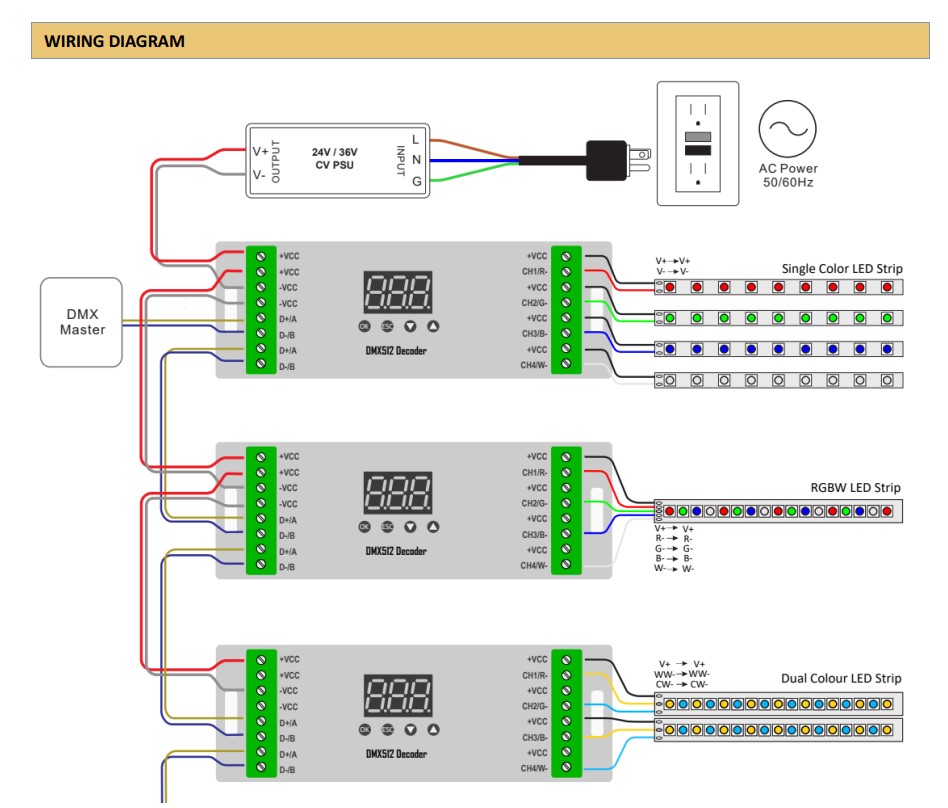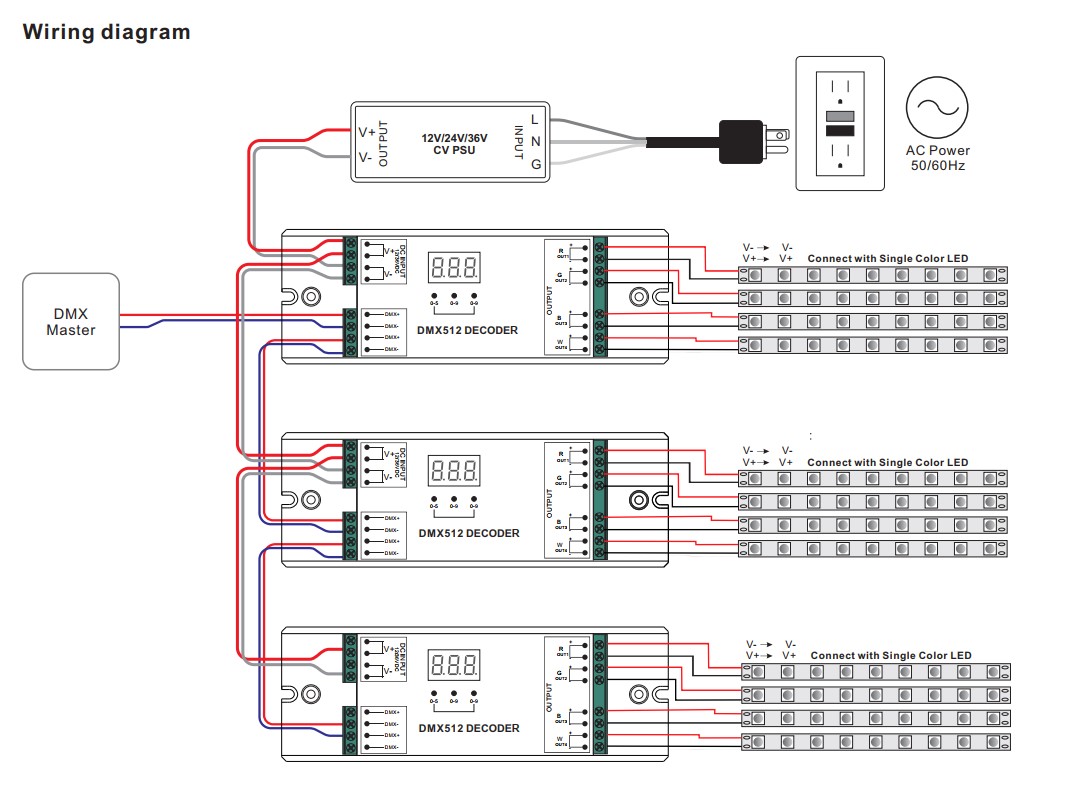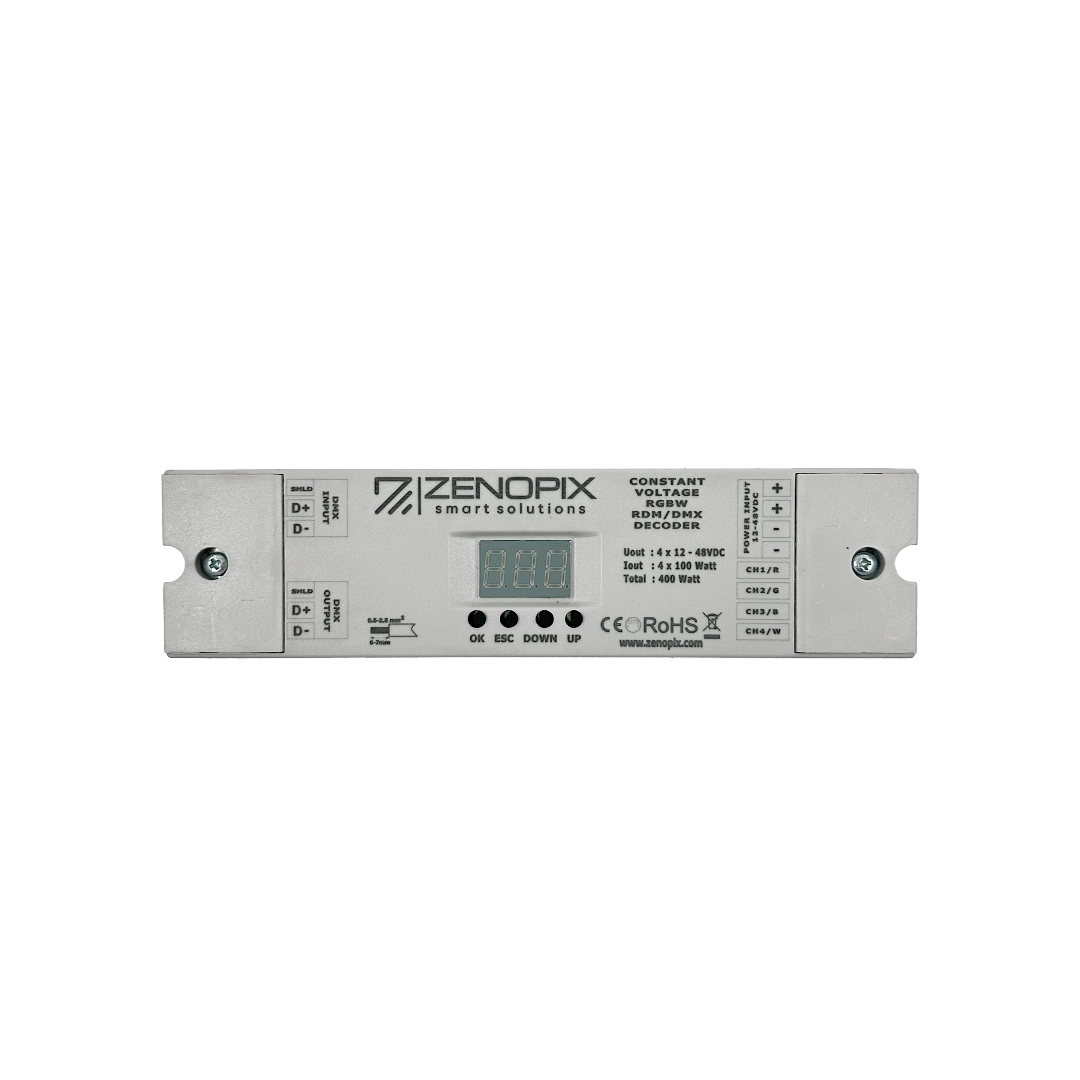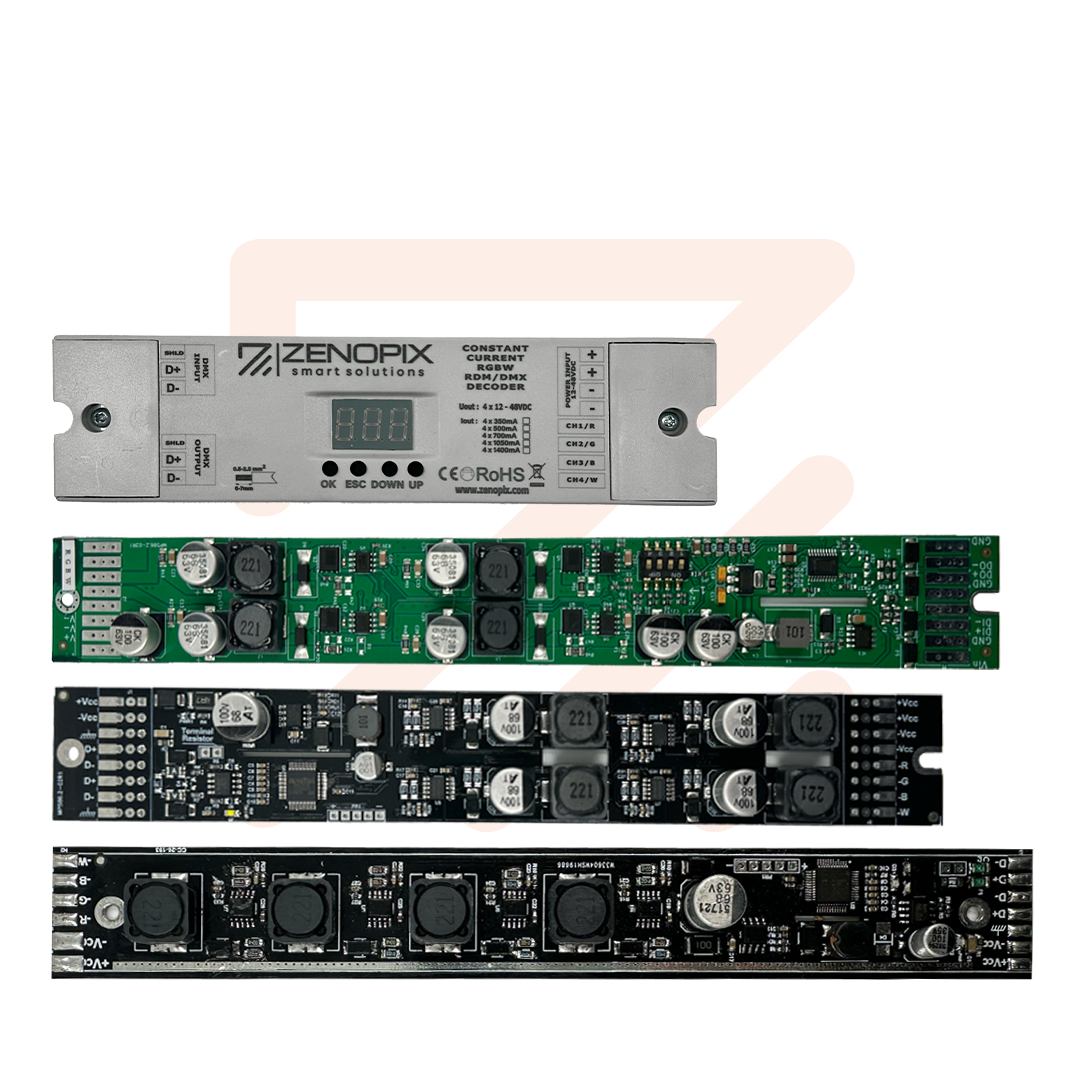Product Information
Product Description
The Zenopix 4-Channel RDM DMX Constant Voltage Decoder is a control device that operates with DC 12-48V input and is fully compatible with the RDM DMX512 (1990) standard protocol. With 4 output channels, the decoder allows you to manage LED lighting systems effectively and safely.
RDM addressing can be done remotely using RDM address writer or DMX addressing can be assigned via the buttons on the decoder, with the address displayed on a digital screen. Using a DMX main controller, you can instantly turn the lighting system on or off, or dim it using PWM digital dimming, providing a visually impressive effect. The dimming range is 0.1% to 100%, with LEDs starting at 0.01%.
The device offers broad compatibility with all RDM and DMX512 main controllers and players. Its intelligent power protection ensures long-term safe operation. Multiple voltage and current options are available for different LED power levels, and you can select 1-4 DMX output channels. High-resolution control is also possible with 16bit (65536 levels) or 8bit (256 levels) grayscale options.
Built-in programs and buttons on the decoder allow users to easily switch between 4-channel dimming modes. DMX on/off and dimming functions provide flexible control. The Zenopix 4-Channel DMX Constant Voltage Decoder is fully compatible with international DMX products and comes with a 2/5-year warranty.
Features:
- DC 12-48V input
- 4-channel DMX output
- Full compatibility with RDM DMX512 (1990) protocol
- DMX addressing with digital display
- PWM digital dimming (0.1% – 100%)
- 16bit or 8bit grayscale options
- Broad compatibility and intelligent power protection
- 1/2/3/4 DMX output channel selection
- Built-in programs and user-friendly buttons
- DMX on/off and dimming functions
- 2/5-year warranty
The Zenopix 4-Channel RDM DMX Constant Voltage Decoder provides a reliable and flexible solution for professional LED lighting projects.
| Dimming Interface | RDM / DMX |
| Input Voltage Range | 12-48VDC |
| Output Voltage Range | 12-48VDC |
| Maximum Output Voltage | 48VDC |
| No-load Output Voltage | 0VDC |
| Output Currents | Max. 20A (5Ax4CH) |
| Output Power | Max. 396 W (4CH) |
| Dimming Range | 0~100%, LED start at 0.1% possible |
| PWM Dimming Frequency | 100Hz – 90,000 Hz |
| Ripple & Noise | ≤2V (no dim) |
| Operating Temperature | ta: 50°C tc: 90°C |
| Operating Humidity | 20 ~ 95%RH, without condensation |
| Storage Temperature and Humidity | -40°C ~ 80°C, 10~95%RH |
| Temperature Coefficient | ±0.03%/°C (0-50°C) |
| Dimensions | 180×46.5×22mm (L×W×H) |
| Weight (G.W.) | 165g±10g |



| Zenopix Decoder Mini Brochure | Download |
There are two main types of LED drivers; these are also known as LED power supplies or LED transformers. Drivers that provide a constant voltage output are typically used to power LED strips or bars, while drivers with constant current output are primarily used for high-power downlights and floor lights.
Frequently Asked Questions About LED Drivers
1. What is an LED driver and how does it work?
2. Which LED driver do I need?
3. Do I need series or parallel connection?
4. Does my driver need to be waterproof?
5. Will your dimmable LED drivers work with a dimming controller?
6. Can you supply other LED drivers not listed on your site?
7. I want to dim or darken color-changing LED bars, do I need a dimmable driver?
8. What is the difference between an LED driver and a transformer?
9. How do I mount it?
10. How will it connect to existing LED lights, and will I need other connector blocks or accessories?
1. What is an LED driver and how does it work?
LED lights operate at lower and more precise voltages compared to traditional lights like halogen and incandescent bulbs. They also operate on DC (Direct Current) rather than AC (Alternating Current).
An LED driver is an electrical device that converts the mains voltage of 230V AC to DC, while also reducing the voltage for LEDs. DC voltage requirements for LEDs are primarily classified as fixed voltages such as 12V, 24V, 36V, and 48V DC. Some LED lights typically require a constant current source of 350mA or 700mA.
Most LED drivers have a standard mains voltage input (230V AC), but the output voltage needs to be specified when ordering. Additionally, RGB or RGBW decoders are sold separately from LED drivers.
2. Which LED driver do I need?
This depends on the type of LED light or lights you need to power. For a fixed color LED strip, you will need a fixed voltage LED driver with 12V or 24V DC output.
The wattage (or size) of the driver is determined by the load of the LED strip or the total wattage. This is calculated by multiplying the watt per meter of the LED strip by its length. For extended operations, you can connect multiple LED drivers in the same circuit by adding amplifiers.
Some LED lights, such as LED floor and marker lights, require constant current and 350mA or 700mA supply. These products also require specific voltages, so ensuring compatibility is important. Whenever possible, it is better to use products recommended by manufacturers that have been extensively tested.
Some manufacturers do not offer dimmable constant current LED drivers. If you are looking for one and unsure if it will work, you should follow these three rules:
A. Typically, there are drivers that are 350mA or 700mA, but versions that can be 500mA or 1050mA should also be considered, and always refer to the LED usage manual.
B. Make sure that the wattage value of the driver is higher than the total wattage value of the LED lights connected to it.
C. Check if the voltage is correct. Constant current LED drivers have very peculiar voltage outputs; some have very wide ranges like 2-52 volts, but some are very specific. If you are connecting multiple lights to a driver, you need to add up their required voltages and ensure they are within the capacity of the driver. If in doubt, please contact us for advice.
3. Series or parallel wiring?
Fixed voltage products are connected in parallel, while constant current products are connected in series. If you are connecting only one LED light to a constant current LED driver, the connection is actually the same as with a fixed voltage driver. However, when you connect multiple LEDs, you connect them to each other like a daisy chain. The diagram below shows how to connect them in series:
Constant current LEDs should be connected in series. This ensures that a regulated current flows to each LED in the circuit. The most commonly used constant current values are 350mA and 700mA.
Dimming constant current drivers is similar to fixed voltage drivers, and both types can be dimmed with an LED-compatible dimmer switch. Always check whether the driver is mains or TRIAC dimmable. Many 0-10V dimmable constant current LED drivers require an additional cable and an analog 0-10V dimming switch.
Ensure wattage; always ensure that the correct combination of LED connection parts and drivers is selected. The total wattage of all LED lights should not exceed the maximum wattage of the LED driver. When dimming LEDs, you may also need to consider the minimum wattage of the driver; sometimes you need to load the driver up to 60% to prevent flickering.
4. Do my drivers need to be waterproof?
This depends on where they are mounted. Like most electrical products, LED drivers have an IP (Ingress Protection) rating, which indicates their resistance to dust and water. The first digit denotes dust resistance and the second denotes water resistance. Something rated IP65 is resistant to dust and can withstand water jets, but it's not suitable for immersion. For underwater installations, you would need a product rated IP68.
If mounting outdoors, it should be fully waterproof and housed in an electrical enclosure.
5. Will your dimmable LED drivers work with my dimmer?
This really depends on which dimmer switch you have. It should be a forward or reverse edge dimmer switch for beginners, and you need to make sure it can handle the load.
We offer various LED-compatible dimmer switches that work perfectly.
6. Can you supply other LED drivers not listed on your site?
Yes, we can provide many other types of LED drivers and can even supply custom-made drivers on request. These are available in both dimmable and non-dimmable versions.,
7. I want to dim a color-changing LED strip. Do I need a dimmable driver?
No, when dimming a color-changing LED strip, you dim it using a controller that changes the color. A non-dimmable driver is used for such installations.
8. What's the difference between an LED driver and a transformer?
An LED driver (or LED power supply) has a DC (Direct Current) output. The majority of LED lights require DC input. Transformers, primarily used in low-voltage halogen lamps, convert high-voltage AC to low-voltage AC.
9. How will it be mounted?
If mounting to any cabinet or panel, ensure there are screw holes for direct surface mounting.
10. How will it connect to existing lights, and will I need other connector blocks or accessories?
If it's a constant current LED driver, we have a range of constant current connector blocks that assist with wiring.


